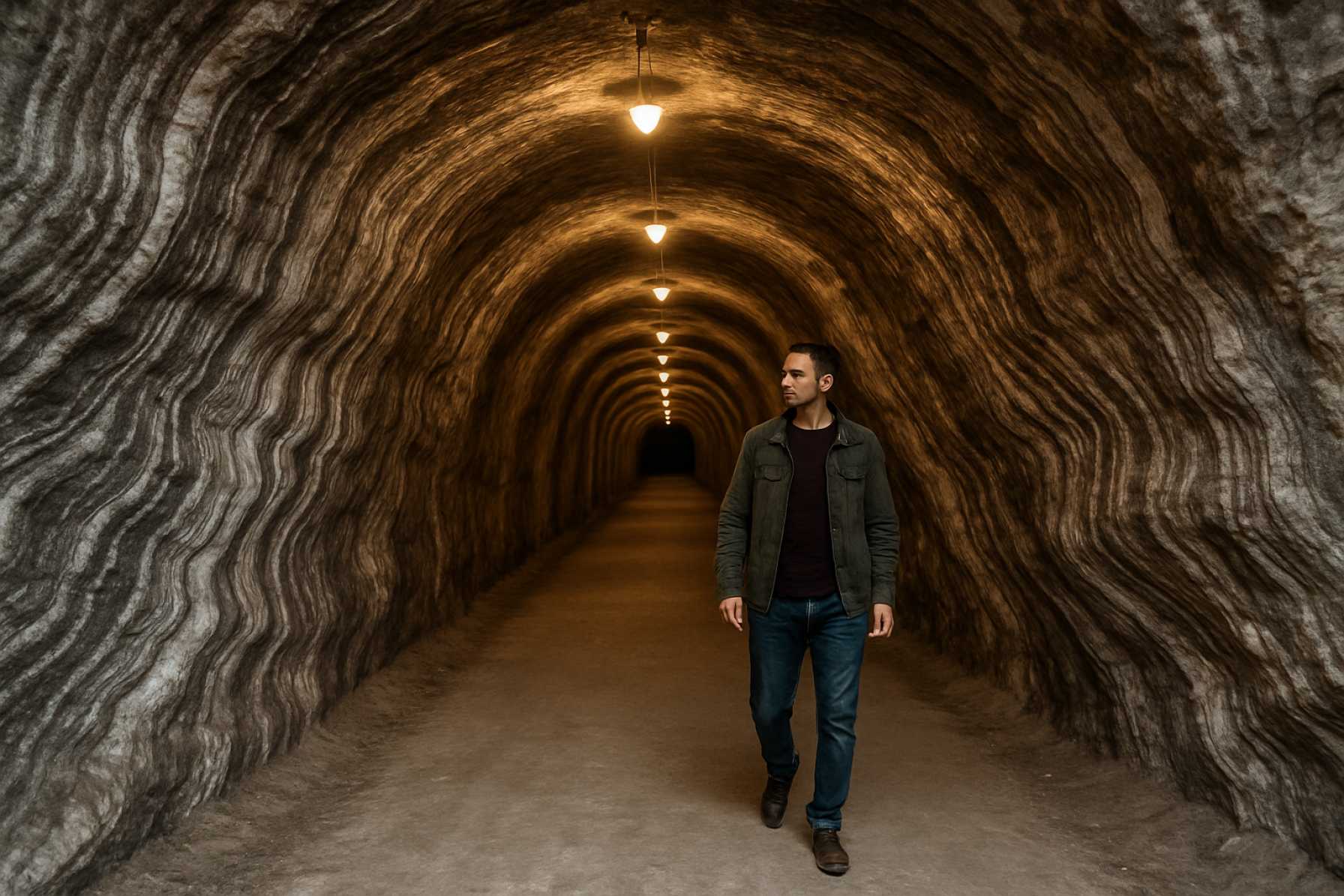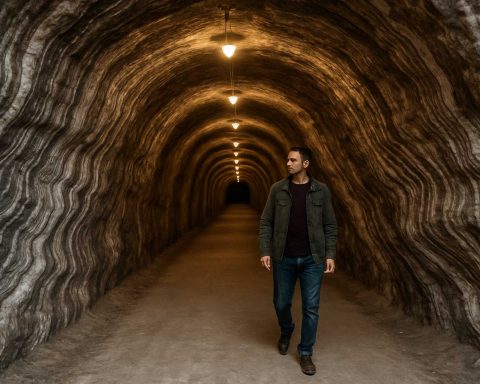Inside Duzdag Salt Mine: Exploring Azerbaijan’s Legendary Subterranean Sanctuary and Its Remarkable Therapeutic Legacy
- Introduction to Duzdag Salt Mine
- Geological Formation and Salt Deposits
- Historical Significance and Archaeological Discoveries
- Mining Techniques: Past and Present
- Therapeutic Uses and Speleotherapy
- Duzdag in Azerbaijani Culture and Folklore
- Economic Impact and Salt Production
- Tourism and Visitor Experience
- Environmental Considerations and Conservation
- Future Prospects and Research Directions
- Sources & References
Introduction to Duzdag Salt Mine
The Duzdag Salt Mine is a significant geological and industrial site located near the city of Nakhchivan in the Nakhchivan Autonomous Republic, an exclave of Azerbaijan. Renowned for its extensive salt reserves, the mine has played a vital role in the region’s history, economy, and culture for millennia. Archaeological evidence suggests that salt extraction at Duzdag dates back to the 3rd–2nd millennia BCE, making it one of the oldest known salt mining sites in the world. The mine’s name, “Duzdag,” translates to “Salt Mountain” in Azerbaijani, reflecting both its physical characteristics and its central importance to local communities.
The Duzdag Salt Mine is situated within a large salt mountain, which is part of the broader geological formations of the Lesser Caucasus. The salt deposits are believed to have formed during the Neogene period, and the site contains both rock salt and brine. Over centuries, the mine has been a crucial source of salt not only for the local population but also for trade routes that connected the South Caucasus with neighboring regions. The strategic location of Duzdag contributed to the development of Nakhchivan as a regional hub for commerce and settlement.
In modern times, the Duzdag Salt Mine continues to be an important industrial asset for Azerbaijan. The mine is operated under the jurisdiction of the Nakhchivan Autonomous Republic, which is a self-governing region within Azerbaijan, and is subject to oversight by national authorities such as the President of the Republic of Azerbaijan and the Ministry of Economy of the Republic of Azerbaijan. The extracted salt is used for a variety of purposes, including food processing, industrial applications, and road maintenance.
Beyond its economic significance, the Duzdag Salt Mine is also recognized for its unique microclimate, which has therapeutic properties. The mine’s underground galleries have been adapted into a speleotherapy center, attracting visitors seeking treatment for respiratory ailments. This dual role as both an industrial site and a health destination underscores the multifaceted importance of Duzdag in the region. The site is also a subject of ongoing geological and archaeological research, further highlighting its value as a natural and cultural heritage landmark.
Geological Formation and Salt Deposits
The Duzdag Salt Mine, located near Nakhchivan in Azerbaijan, is one of the most significant and ancient salt mining sites in the region. The geological formation of the Duzdag Salt Mine is primarily attributed to the extensive evaporite processes that occurred during the Neogene period, approximately 5 to 23 million years ago. During this era, the area was covered by shallow seas and lagoons, which, under arid climatic conditions, led to the evaporation of seawater and the subsequent precipitation of thick layers of halite (rock salt) and other evaporite minerals.
The Duzdag salt deposit is part of the larger Nakhchivan salt basin, which is characterized by its massive, lens-shaped salt domes. These domes were formed as a result of tectonic activity, where the less dense salt layers were forced upwards through overlying sedimentary rocks, creating prominent geological structures. The Duzdag salt dome itself is estimated to be several hundred meters thick and extends over a considerable area, making it a substantial source of high-purity sodium chloride (NaCl).
Geological surveys and studies have revealed that the Duzdag deposit contains not only halite but also minor quantities of other evaporite minerals such as gypsum and anhydrite. The purity of the salt in Duzdag is notably high, which has contributed to its long-standing exploitation for both industrial and culinary purposes. The mine’s salt layers are horizontally stratified, allowing for relatively straightforward extraction through both traditional and modern mining techniques.
The significance of the Duzdag Salt Mine extends beyond its geological features. Archaeological evidence suggests that salt extraction at Duzdag dates back to the 3rd millennium BCE, making it one of the oldest known salt mining sites in the world. The continuous exploitation of these deposits over millennia highlights the enduring economic and cultural importance of the site for the region.
Today, the Duzdag Salt Mine remains a vital resource for Azerbaijan, supporting local industries and contributing to the country’s mineral wealth. The site is also notable for its unique microclimate, which has led to the development of speleotherapy facilities within the mine, leveraging the stable temperature and humidity conditions for therapeutic purposes. Oversight and research into the geological and economic aspects of the Duzdag Salt Mine are conducted by national bodies such as the Azerbaijan National Academy of Sciences, which plays a key role in the study and preservation of Azerbaijan’s geological heritage.
Historical Significance and Archaeological Discoveries
The Duzdag Salt Mine, located near Nakhchivan in Azerbaijan, is one of the world’s oldest known salt extraction sites, with a history that stretches back several millennia. Archaeological evidence indicates that salt mining activities at Duzdag began as early as the 3rd millennium BCE, making it a significant site for understanding the development of early mining technologies and trade in the South Caucasus region. The mine’s strategic location along ancient trade routes contributed to the economic and cultural development of the area, as salt was a highly valued commodity for both dietary and preservative purposes.
Extensive archaeological excavations at Duzdag have uncovered a wealth of artifacts and structural remains that shed light on the mine’s historical significance. Among the most notable discoveries are ancient mining tools, pottery fragments, and remnants of wooden supports used in the tunnels, which provide insight into the techniques employed by early miners. Radiocarbon dating of organic materials found within the mine has confirmed continuous or recurrent use of the site from the Bronze Age through the medieval period. These findings underscore the mine’s long-standing role in regional subsistence and trade networks.
The Duzdag Salt Mine is also significant for its association with the ancient city of Nakhchivan, which served as a major hub in the exchange of goods across the Caucasus and beyond. Historical records and archaeological data suggest that salt from Duzdag was transported over considerable distances, reaching communities far from its source. This widespread distribution highlights the mine’s importance not only as a local resource but also as a driver of broader economic and social interactions in antiquity.
In recognition of its historical and archaeological value, the Duzdag Salt Mine has been the focus of collaborative research projects involving Azerbaijani and international experts. These efforts have contributed to a deeper understanding of early mining practices and the role of salt in ancient societies. The site is protected and studied under the auspices of the Nakhchivan Autonomous Republic and the Government of the Republic of Azerbaijan, both of which oversee heritage conservation and archaeological research in the region. The ongoing study of Duzdag continues to reveal new information about the technological innovations and cultural exchanges that shaped the history of the South Caucasus.
Mining Techniques: Past and Present
The Duzdag Salt Mine, located near Nakhchivan in Azerbaijan, is one of the oldest known salt extraction sites in the world, with a history stretching back several millennia. Archaeological evidence suggests that salt mining at Duzdag began as early as the 3rd millennium BCE, making it a significant site for understanding the evolution of mining techniques in the region. Early miners at Duzdag employed primitive methods, using stone and bone tools to manually extract salt from exposed rock faces. These early techniques relied heavily on physical labor, with miners chiseling out salt blocks and transporting them by hand or with simple sledges.
As mining knowledge advanced, so did the methods used at Duzdag. By the medieval period, miners had begun to employ more sophisticated tools made of metal, such as iron picks and hammers, which allowed for deeper penetration into the salt deposit. The development of basic tunneling techniques enabled the creation of horizontal adits and vertical shafts, facilitating access to richer salt seams while improving safety and efficiency. Remnants of these ancient tunnels and mining implements have been uncovered during archaeological excavations, providing valuable insights into the technological progression at the site.
In the modern era, the Duzdag Salt Mine has undergone significant transformation, adopting contemporary mining technologies to increase productivity and ensure worker safety. Today, the mine utilizes mechanized drilling and cutting equipment to extract salt more efficiently from the extensive underground deposit. Ventilation systems have been installed to maintain air quality within the tunnels, and modern transportation methods, such as conveyor belts and mine carts, are used to move the extracted salt to the surface. These advancements have not only boosted output but also reduced the physical strain on miners and minimized environmental impact.
The Duzdag Salt Mine is currently managed by local authorities under the jurisdiction of the Nakhchivan Autonomous Republic, which is an exclave of Azerbaijan. The site is also notable for its therapeutic salt caves, which are used for speleotherapy—a treatment for respiratory ailments—demonstrating the mine’s multifaceted significance beyond salt production. The ongoing preservation and study of Duzdag’s mining heritage are supported by organizations such as the Government of the Republic of Azerbaijan, which recognizes the mine as a cultural and industrial landmark.
Therapeutic Uses and Speleotherapy
The Duzdag Salt Mine, located near Nakhchivan in Azerbaijan, is renowned not only for its extensive salt reserves but also for its unique therapeutic applications, particularly in the field of speleotherapy. Speleotherapy refers to the use of the microclimate within natural or artificial salt caves and mines for the treatment of respiratory and certain allergic conditions. The Duzdag Salt Mine has been adapted to serve as a specialized health center, attracting patients from Azerbaijan and neighboring countries seeking relief from chronic respiratory diseases such as asthma, bronchitis, and allergic rhinitis.
The therapeutic environment within the Duzdag Salt Mine is characterized by stable temperature, high humidity, and a unique aerosol composition rich in sodium chloride and trace minerals. These conditions are believed to have anti-inflammatory and mucolytic effects, which can help reduce airway inflammation, improve mucociliary clearance, and decrease the frequency and severity of respiratory symptoms. The mine’s microclimate is also free from common airborne pollutants and allergens, providing a hypoallergenic environment that is particularly beneficial for individuals with respiratory sensitivities.
The Duzdag Physiotherapy Center, established within the mine, offers structured speleotherapy programs. Patients typically spend several hours per day in specially prepared chambers deep within the salt mine, under medical supervision. Clinical observations and patient reports suggest improvements in lung function, reduced medication use, and enhanced quality of life following treatment courses at Duzdag. While the precise mechanisms are still under scientific investigation, the center’s protocols are based on decades of experience and align with speleotherapy practices observed in other salt mines across Eastern Europe.
The therapeutic use of the Duzdag Salt Mine is officially recognized by local health authorities, and the facility operates in accordance with national health regulations. The Ministry of Health of the Republic of Azerbaijan oversees the standards and safety of medical services provided at the site. The Duzdag Salt Mine’s reputation as a center for speleotherapy has contributed to the development of health tourism in the region, with the site being promoted as a unique destination for both medical treatment and wellness.
Ongoing research and collaboration with medical institutions aim to further validate the efficacy of speleotherapy at Duzdag and to optimize treatment protocols for various respiratory conditions. As interest in non-pharmacological therapies grows, the Duzdag Salt Mine stands out as a significant example of how natural geological resources can be harnessed for public health benefits.
Duzdag in Azerbaijani Culture and Folklore
The Duzdag Salt Mine, located near the city of Nakhchivan in Azerbaijan, is not only a significant geological and economic resource but also a prominent symbol in Azerbaijani culture and folklore. The mine’s history stretches back thousands of years, with archaeological evidence indicating that salt extraction at Duzdag began as early as the 3rd millennium BCE. This ancient heritage has deeply embedded Duzdag in the collective memory and traditions of the Azerbaijani people.
In Azerbaijani folklore, salt is often associated with purity, hospitality, and the sustenance of life. The Duzdag Salt Mine, as one of the oldest known salt mines in the region, has become a focal point for stories and legends that emphasize the value of salt as a precious commodity. Traditional tales recount how salt from Duzdag was used not only for culinary purposes but also as a means of preserving food, a vital practice in the arid climate of Nakhchivan. The mine’s salt was historically traded along the Silk Road, further enhancing its cultural significance and contributing to the prosperity of the region.
Duzdag’s influence extends into Azerbaijani customs and rituals. For example, the act of sharing bread and salt is a time-honored gesture of friendship and trust in Azerbaijani households, symbolizing the unbreakable bond between host and guest. This tradition is often linked to the abundance of salt provided by Duzdag, reinforcing the mine’s role in shaping social practices. Additionally, salt from Duzdag is sometimes used in folk medicine and spiritual rituals, believed to ward off evil and bring good fortune.
The mine also features in local songs, proverbs, and poetry, where it is celebrated as a source of life and resilience. The phrase “bread and salt” appears frequently in Azerbaijani literature, underscoring the mine’s enduring presence in the national consciousness. Furthermore, the Duzdag Salt Mine is a site of communal memory, with generations of families having worked in or benefited from its resources, creating a sense of shared heritage and identity.
Today, the cultural legacy of Duzdag is preserved and promoted through regional museums and cultural initiatives, ensuring that its stories and traditions continue to inspire future generations. The mine’s unique place in Azerbaijani culture is recognized by organizations such as the Azerbaijan Tourism Board, which highlights Duzdag as a destination of both historical and cultural importance.
Economic Impact and Salt Production
The Duzdag Salt Mine, located near Nakhchivan in Azerbaijan, is one of the oldest and most significant salt extraction sites in the region. Its economic impact is multifaceted, encompassing direct salt production, employment, and contributions to local and national economies. The mine has been in operation since ancient times, with archaeological evidence indicating salt extraction activities dating back several millennia. Today, it remains a vital industrial asset for Azerbaijan, both as a source of raw material and as a driver of regional development.
Salt production at Duzdag is primarily based on the extraction of rock salt from extensive underground deposits. The mine is estimated to contain reserves of several hundred million tons, making it a strategic resource for Azerbaijan. Modern mining techniques have enabled efficient extraction and processing, ensuring a steady supply of high-quality salt for various uses, including food processing, chemical industries, and road de-icing. The salt produced at Duzdag is distributed domestically and exported to neighboring countries, contributing to Azerbaijan’s trade balance.
The economic significance of the Duzdag Salt Mine extends beyond raw material production. The facility provides direct employment to hundreds of workers, supporting families and contributing to the socio-economic stability of the Nakhchivan Autonomous Republic. Additionally, the mine stimulates ancillary industries such as transportation, packaging, and equipment maintenance, further amplifying its economic footprint. The presence of the mine has also encouraged infrastructure development in the region, including roads and utilities, which benefit the broader community.
In recent years, the Duzdag Salt Mine has diversified its economic role by developing health tourism. The unique microclimate within the mine’s tunnels is believed to have therapeutic properties, particularly for respiratory ailments. This has led to the establishment of the Duzdag Physiotherapy Center, attracting visitors from Azerbaijan and abroad, and generating additional revenue streams for the local economy. The integration of industrial production with health tourism exemplifies the mine’s adaptive economic strategy.
Oversight and regulation of the Duzdag Salt Mine are managed by relevant Azerbaijani authorities, ensuring sustainable extraction practices and compliance with national standards. The mine’s operations are aligned with the broader economic development goals of Azerbaijan, as articulated by the President of the Republic of Azerbaijan and supported by the Ministry of Ecology and Natural Resources of the Republic of Azerbaijan. These organizations play a crucial role in balancing economic benefits with environmental stewardship and community well-being.
Tourism and Visitor Experience
The Duzdag Salt Mine, located near Nakhchivan in Azerbaijan, has evolved from a historic industrial site into a unique destination for both health tourism and general visitors. The mine, which has been in operation since ancient times, is renowned for its extensive underground tunnels and chambers carved from natural salt deposits. Today, it attracts thousands of tourists annually, drawn by its distinctive microclimate and the therapeutic properties attributed to its salt-rich air.
A central feature of the Duzdag Salt Mine’s tourism appeal is the Duzdag Physiotherapy Center, established within the mine itself. This facility is internationally recognized for its speleotherapy treatments, particularly for respiratory conditions such as asthma and bronchitis. Visitors can stay in specially designed underground wards, where the stable temperature, high humidity, and salt-saturated air are believed to provide significant health benefits. The center operates under the auspices of the Nakhchivan Autonomous Republic’s health authorities, ensuring regulated and safe therapeutic experiences.
Beyond its medical offerings, the Duzdag Salt Mine provides a fascinating visitor experience. Guided tours take guests through illuminated tunnels, showcasing the mine’s geological formations and the history of salt extraction in the region. Informational displays and exhibits detail the mine’s ancient origins, its role in local culture, and the evolution of mining techniques over centuries. The site is accessible to a wide range of visitors, with infrastructure improvements in recent years enhancing safety and comfort.
The mine’s unique environment also supports educational tourism. School groups and researchers frequently visit to study geology, mineralogy, and the environmental adaptations required for underground construction. The Duzdag Salt Mine is promoted as a key attraction by the Azerbaijan Tourism Board, which highlights its combination of natural wonder, historical significance, and health tourism potential.
Visitor amenities at the site include a reception center, souvenir shops, and facilities for rest and refreshment. The mine is open year-round, with peak visitation during the spring and autumn months when the climate is most favorable. The integration of health, history, and hospitality makes the Duzdag Salt Mine a distinctive destination within Azerbaijan’s growing tourism sector, offering a blend of wellness and cultural enrichment for both domestic and international guests.
Environmental Considerations and Conservation
The Duzdag Salt Mine, located near Nakhchivan in Azerbaijan, is one of the oldest and most significant salt extraction sites in the region. Its environmental considerations and conservation efforts are crucial due to the mine’s historical, ecological, and economic importance. The mine’s operations, which involve both traditional and modern extraction techniques, have the potential to impact the surrounding environment, including soil, water resources, and local biodiversity.
One of the primary environmental concerns associated with salt mining is the potential for groundwater contamination. The dissolution of salt can lead to increased salinity in nearby water bodies, which may affect both agricultural activities and drinking water supplies. To mitigate these risks, the Duzdag Salt Mine employs controlled extraction methods and regular monitoring of water quality in the vicinity. These measures are designed to prevent excessive leaching of salt into the environment and to ensure compliance with national environmental standards set by the Ministry of Ecology and Natural Resources of the Republic of Azerbaijan, the governmental authority responsible for environmental protection and sustainable resource management in Azerbaijan.
Another important aspect of environmental management at Duzdag is the preservation of the unique subterranean ecosystem within the mine. The mine’s microclimate, characterized by stable temperature and humidity, supports specialized microbial communities and has been recognized for its therapeutic properties, particularly in the treatment of respiratory diseases. Conservation efforts focus on maintaining the integrity of these underground chambers, minimizing disturbances from mining activities, and regulating visitor access to sensitive areas. The Nakhchivan Autonomous Republic Government, which oversees regional development and heritage conservation, collaborates with scientific institutions to monitor the mine’s ecological status and promote sustainable tourism.
Waste management is also a key consideration. The extraction and processing of salt generate solid waste and brine, which must be handled responsibly to avoid environmental degradation. The mine implements waste minimization strategies and ensures that byproducts are either recycled or disposed of in accordance with environmental regulations. Ongoing research and environmental impact assessments, often conducted in partnership with local universities and the Ministry of Ecology and Natural Resources of the Republic of Azerbaijan, guide the adoption of best practices in mine rehabilitation and land restoration.
In summary, the Duzdag Salt Mine’s environmental considerations encompass water protection, ecosystem conservation, and responsible waste management. Through regulatory oversight, scientific collaboration, and community engagement, the mine strives to balance resource extraction with the preservation of its unique natural and cultural heritage.
Future Prospects and Research Directions
The Duzdag Salt Mine, located near Nakhchivan in Azerbaijan, is one of the oldest known salt extraction sites in the world, with a history dating back several millennia. As global interest in sustainable resource management and heritage conservation grows, the future prospects and research directions for the Duzdag Salt Mine are increasingly significant. Ongoing and future research is expected to focus on several key areas, including sustainable mining practices, health tourism, archaeological exploration, and environmental monitoring.
One of the primary future directions involves the implementation of advanced, environmentally friendly mining technologies. The adoption of modern extraction methods can help minimize ecological impact while maximizing resource efficiency. Research into the mine’s unique microclimate and its effects on respiratory health has already led to the development of speleotherapy facilities within the mine, attracting both local and international visitors seeking alternative treatments for respiratory conditions. Continued scientific studies are likely to further validate and optimize these therapeutic applications, potentially positioning Duzdag as a leading center for health tourism in the region.
Archaeological research remains a vital aspect of the Duzdag Salt Mine’s future. The site offers a rare opportunity to study ancient mining techniques and the socio-economic history of the region. Collaborative projects between Azerbaijani institutions and international archaeological organizations are expected to expand, utilizing advanced technologies such as ground-penetrating radar and 3D mapping to uncover and preserve historical artifacts and mining infrastructure. These efforts not only contribute to the understanding of early human industry but also support the development of the site as a cultural heritage destination.
Environmental monitoring and conservation are also central to the mine’s future. As salt mining can have significant impacts on local ecosystems, ongoing research is needed to assess and mitigate potential risks such as groundwater contamination and landscape alteration. Partnerships with environmental agencies and scientific bodies will be crucial in developing comprehensive management plans that balance economic, health, and heritage interests.
Finally, the integration of the Duzdag Salt Mine into broader regional development strategies is anticipated. This includes enhancing infrastructure, promoting educational programs, and fostering international cooperation. Organizations such as the Government of the Republic of Azerbaijan and the UNESCO are likely to play important roles in supporting research, conservation, and sustainable development initiatives at the site. As these efforts progress, the Duzdag Salt Mine is poised to serve as a model for the responsible management of natural and cultural resources.









